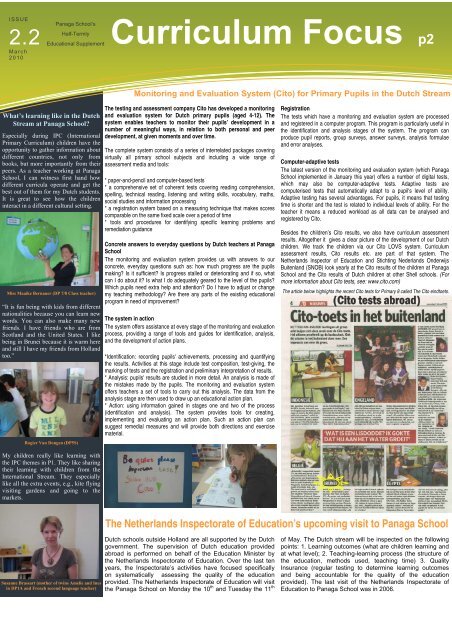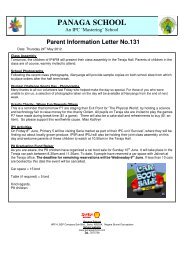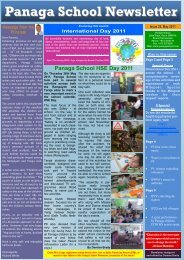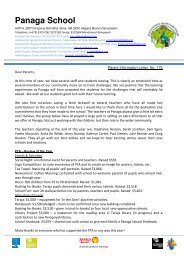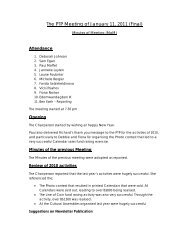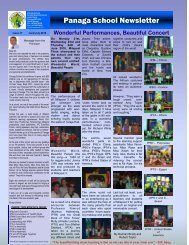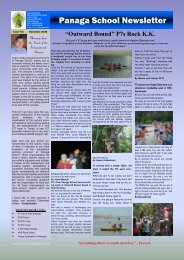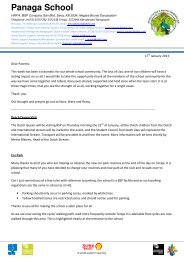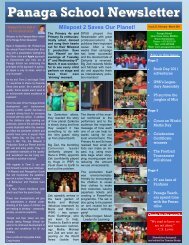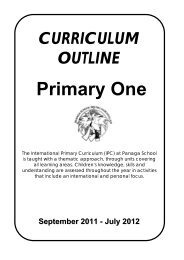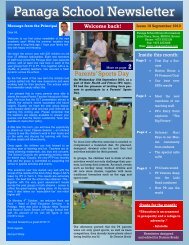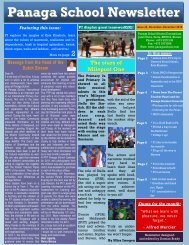Curriculum Focus - Panaga School
Curriculum Focus - Panaga School
Curriculum Focus - Panaga School
You also want an ePaper? Increase the reach of your titles
YUMPU automatically turns print PDFs into web optimized ePapers that Google loves.
ISSUE<br />
<strong>Panaga</strong> <strong>School</strong>’s<br />
Half-Termly<br />
2.2 Educational Supplement<br />
March<br />
2010<br />
<strong>Curriculum</strong> <strong>Focus</strong><br />
p2<br />
What’s learning like in the Dutch<br />
Stream at <strong>Panaga</strong> <strong>School</strong><br />
Especially during IPC (International<br />
Primary <strong>Curriculum</strong>) children have the<br />
opportunity to gather information about<br />
different countries, not only from<br />
books, but more importantly from their<br />
peers. As a teacher working at <strong>Panaga</strong><br />
<strong>School</strong>, I can witness first hand how<br />
different curricula operate and get the<br />
best out of them for my Dutch students.<br />
It is great to see how the children<br />
interact in a different cultural setting.<br />
Miss Maaike Bernauer (DP 7/8 Class teacher)<br />
“It is fun being with kids from different<br />
nationalities because you can learn new<br />
words. You can also make many new<br />
friends. I have friends who are from<br />
Scotland and the United States. I like<br />
being in Brunei because it is warm here<br />
and still I have my friends from Holland<br />
too.”<br />
Rogier Van Dongen (DP5S)<br />
My children really like learning with<br />
the IPC themes in P1. They like sharing<br />
their learning with children from the<br />
International Stream. They especially<br />
like all the extra events, e.g., kite flying<br />
visiting gardens and going to the<br />
markets.<br />
Monitoring and Evaluation System (Cito) for Primary Pupils in the Dutch Stream<br />
The testing and assessment company Cito has developed a monitoring<br />
and evaluation system for Dutch primary pupils (aged 4-12). The<br />
system enables teachers to monitor their pupils’ development in a<br />
number of meaningful ways, in relation to both personal and peer<br />
development, at given moments and over time.<br />
The complete system consists of a series of interrelated packages covering<br />
virtually all primary school subjects and including a wide range of<br />
assessment media and tools:<br />
* paper-and-pencil and computer-based tests<br />
* a comprehensive set of coherent tests covering reading comprehension,<br />
spelling, technical reading, listening and writing skills, vocabulary, maths,<br />
social studies and information processing<br />
* a registration system based on a measuring technique that makes scores<br />
comparable on the same fixed scale over a period of time<br />
* tools and procedures for identifying specific learning problems and<br />
remediation guidance<br />
Concrete answers to everyday questions by Dutch teachers at <strong>Panaga</strong><br />
<strong>School</strong><br />
The monitoring and evaluation system provides us with answers to our<br />
concrete, everyday questions such as: how much progress are the pupils<br />
making Is it sufficient Is progress stalled or deteriorating and if so, what<br />
can I do about it Is what I do adequately geared to the level of the pupils<br />
Which pupils need extra help and attention Do I have to adjust or change<br />
my teaching methodology Are there any parts of the existing educational<br />
program in need of improvement<br />
The system in action<br />
The system offers assistance at every stage of the monitoring and evaluation<br />
process, providing a range of tools and guides for identification, analysis,<br />
and the development of action plans.<br />
*Identification: recording pupils' achievements, processing and quantifying<br />
the results. Activities at this stage include test composition, test-giving, the<br />
marking of tests and the registration and preliminary interpretation of results.<br />
* Analysis: pupils' results are studied in more detail. An analysis is made of<br />
the mistakes made by the pupils. The monitoring and evaluation system<br />
offers teachers a set of tools to carry out this analysis. The data from the<br />
analysis stage are then used to draw up an educational action plan.<br />
* Action: using information gained in stages one and two of the process<br />
(identification and analysis). The system provides tools for creating,<br />
implementing and evaluating an action plan. Such an action plan can<br />
suggest remedial measures and will provide both directions and exercise<br />
material.<br />
Registration<br />
The tests which have a monitoring and evaluation system are processed<br />
and registered in a computer program. This program is particularly useful in<br />
the identification and analysis stages of the system. The program can<br />
produce pupil reports, group surveys, answer surveys, analysis formulae<br />
and error analyses.<br />
Computer-adaptive tests<br />
The latest version of the monitoring and evaluation system (which <strong>Panaga</strong><br />
<strong>School</strong> implemented in January this year) offers a number of digital tests,<br />
which may also be computer-adaptive tests. Adaptive tests are<br />
computerised tests that automatically adapt to a pupil's level of ability.<br />
Adaptive testing has several advantages. For pupils, it means that testing<br />
time is shorter and the test is related to individual levels of ability. For the<br />
teacher it means a reduced workload as all data can be analysed and<br />
registered by Cito.<br />
Besides the children’s Cito results, we also have curriculum assessment<br />
results. Altogether it gives a clear picture of the development of our Dutch<br />
children. We track the children via our Cito LOVS system. <strong>Curriculum</strong><br />
assessment results, Cito results etc. are part of that system. The<br />
Netherlands Inspector of Education and Stichting Nederlands Onderwijs<br />
Buitenland (SNOB) look yearly at the Cito results of the children at <strong>Panaga</strong><br />
<strong>School</strong> and the Cito results of Dutch children at other Shell schools. (For<br />
more information about Cito tests, see: www.cito.com)<br />
The article below highlights the recent Cito tests for Primary 8 called The Cito eindtoets.<br />
(Cito tests abroad)<br />
Susanne Brassart (mother of twins Amelie and Ines<br />
in DP1A and French second language teacher)<br />
The Netherlands Inspectorate of Education’s upcoming visit to <strong>Panaga</strong> <strong>School</strong><br />
Dutch schools outside Holland are all supported by the Dutch<br />
government. The supervision of Dutch education provided<br />
abroad is performed on behalf of the Education Minister by<br />
the Netherlands Inspectorate of Education. Over the last ten<br />
years, the Inspectorate’s activities have focused specifically<br />
on systematically assessing the quality of the education<br />
provided. The Netherlands Inspectorate of Education will visit<br />
the <strong>Panaga</strong> <strong>School</strong> on Monday the 10 th and Tuesday the 11 th<br />
of May. The Dutch stream will be inspected on the following<br />
points: 1. Learning outcomes (what are children learning and<br />
at what level); 2. Teaching-learning process (the structure of<br />
the education, methods used, teaching time) 3. Quality<br />
Insurance (regular testing to determine learning outcomes<br />
and being accountable for the quality of the education<br />
provided). The last visit of the Netherlands Inspectorate of<br />
Education to <strong>Panaga</strong> <strong>School</strong> was in 2006.


